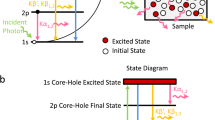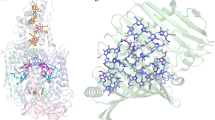Abstract
The spectroscopic and photophysical properties of the biologically important plant antioxidant quercetin in organic solvents, polymer films of polyvinyl alcohol, and a buffer solution at pH 7.0 are studied by stationary luminescence and femtosecond laser spectroscopy at room temperature and 77 K. The large magnitude of the dipole moment of the quercetin molecule in the excited Franck–Condon state μ FC e = 52.8 C m indicates the dipolar nature of quercetin in this excited state. The transient induced absorption spectra S 1→S n in all solvents are characterized by a short-wave band at λ maxabs = 460 nm with exponential decay times in the range of 10.0–20.0 ps. In the entire spectral range at times of >100 ps, no residual induced absorption was observed that could be attributed to the triplet–triplet transitions Т 1 → Т k in quercetin. In polar solvents, two-band fluorescence was also recorded at room temperature, which is due to the luminescence of the initial enol form of quercetin (~415 nm) and its keto form with a transferred proton (550 nm). The short-wave band is absent in nonpolar 2-methyltetrahydrofuran (2-MTHF). The spectra of fluorescence and fluorescence excitation exhibit a low dependence on the wavelength of excitation and detection, which may be related to the solvation and conformational changes in the quercetin molecule. Decreasing the temperature of a glassy-like freezing quercetin solution in ethanol and 2-MTHF to 77 K leads to a strong increase in the intensity (by a factor of ~100) of both bands. The energy circuits for the proton transfer process are proposed depending on the polarity of the medium. The main channel for the exchange of electronic excitation energy in the quercetin molecule at room temperature is the internal conversion S 1 ⇝ S 0, induced by the state with a proton transfer.
Similar content being viewed by others
References
A. Rothwell, A. J. Day, and M. R. A. Morgan, J. Agric. Food Chem. 53, 4355 (2005).
H. Schilcher, B. Patz, and K. Ch. Schimmel, Ärctezeitschr. Naturheilverfahren 31, 819 (1990).
A. Gaberšcik, M. Voncina, T. Trošt, M. Germ, and L. O. Björn, J. Photochem. Photobiol. B 66, 36 (2002).
St. Rusnyak and A. Szent-Györgyi, Nature 13, 798 (1936).
P. G. Pietta, J. Nat. Prod. 63, 1035 (2000).
S. Nagai, K. Ohara, and K. Mukai, J. Phys. Chem. B 109, 4234 (2005).
H. A. Milane, G. Ubeaud, T. F. Vandamme, and L. Jung, Biorg. Med. Chem. 12, 3627 (2004).
S. V. Jovanovic, S. Steenken, Y. Hara, and M. G. Simie, J. Chem. Soc., Perkin Trans., No. 2, 2497 (1996).
V. A. Kostyuk and A. I. Potapovich, Bioradicals and Bioantioxidants (Belorus. Gos. Univ., Minsk, 2004) [in Russian].
S. L. Bondarev and V. N. Knyukshto, J. Lumin. 142, 136 (2013).
E. V. Bondaryuk and V. V. Senchuk, Vestn. Belorus. Univ., Ser. 2, No. 2, 27 (2006).
J. A. Mezzetti, S. Protti, C. Lapouge, and J.-P. Cornard, Phys. Chem. Chem. Phys. 13, 6858 (2011).
E. Falkovskaia, P. K. Sengupta, and M. Kasha, Chem. Phys. Lett. 297, 109 (1998).
P.-T. Chou, Y.-C. Chen, W.-C. Yu, and Y.-M. Cheng, Chem. Phys. Lett. 340, 89 (2001).
J. C. Valle, J. Chem. Phys. 124, 104506 (2006).
S. Höfener, P. C. Kooijman, and J. Groen, Phys. Chem. Chem. Phys. 15, 12572 (2013).
D. McMorrow and M. Kasha, J. Phys. Chem. 88, 2235 (1984).
P. Chou, D. McMorrow, T. J. Aartsma, and M. Kasha, J. Phys. Chem. 88, 4596 (1984).
A. Sytnik and M. Kasha, Proc. Natl. Acad. Sci. USA 91, 8627 (1994).
M. L. Martinez, L. S. Shannong, and P. T. Chou, J. Am. Chem. Soc. 113, 5881 (1991).
S. L. Bondarev, V. N. Knyukshto, S. A. Tikhomirov, and O. V. Buganov, Zh. Prikl. Spektrosk. 6, 837 (2015).
E. A. Borisevich, V. N. Knyukshto, A. N. Kozyrev, and K. N. Solov’ev, Opt. Spectrosc. 74, 129 (1993).
J. N. Demas and G. A. Crosby, J. Chem. Phys. 75, 991 (1971).
N. A. Borisevich, O. V. Buganov, S. A. Tikhomirov, G. B. Tolstorozhev, and G. L. Shkred, Quantum Electron. 29, 780 (1999).
E. MacRae, J. Phys. Chem. 61, 562 (1957).
N. G. Bakhshiev, M. I. Knyazhanskii, V. I. Minkin, O. A. Osipov, and G. V. Saidov, Usp. Khim. 38, 1643 (1969).
S. Domagala, P. Munshi, M. Ahmed, B. Guillot, and C. Jelsch, Acta. Crystallogr. B 67, 63 (2011).
C. Reichardt, Solvents and Solvent Effects in Organic Chemistry (Wiley, Weinheim, 2003; Khimiya, Leningrad, 1973), rus. p.151.
R. H. M. van de Leur, Polymer 35, 2691 (1994).
P. Matteini, A. Gott, and G. Agati, Monatsh. Chem. 141, 793 (2010).
J. P. Cornard, A. C. Boudet, and C. Merlin, J. Mol. Struct. 508, 37 (1999).
M. Kasha, in Physical and Chemical Mechanisms in Molecular Radiation Biology, Ed. by W. A. Glass and M. N. Varma (Plenum, New York, London, 1991), p.231.
S. J. Formosinho and L. G. Arnaut, J. Photochem. Photobiol. A 75, 21 (1993).
B. Dick and N. P. Ernsting, J. Phys. Chem. 91, 4261 (1987).
M. E. Rozenberg, Vinyl Acetate Polymers (Khimiya, Leningrad, 1983) [in Russian].
Y. Norikane, H. Itoh, and A. Arai, J. Photochem. Photobiol. A 161, 163 (2004).
V. Avila and C. M. Previtali, J. Chem. Soc., Perkin Trans. II 2, 2281 (1995).
R. Simkovitch and D. Huppert, J. Phys. Chem. B 119, 10244 (2015).
Author information
Authors and Affiliations
Corresponding author
Additional information
Original Russian Text © S.L. Bondarev, S.A. Tikhomirov, O.V. Buganov, V.N. Knyukshto, T.F. Raichenok, 2017, published in Optika i Spektroskopiya, 2017, Vol. 122, No. 3, pp. 464–474.
Rights and permissions
About this article
Cite this article
Bondarev, S.L., Tikhomirov, S.A., Buganov, O.V. et al. Fluorescence and picosecond induced absorption from the lowest singlet excited states of quercetin in solutions and polymer films. Opt. Spectrosc. 122, 452–461 (2017). https://doi.org/10.1134/S0030400X17030031
Received:
Published:
Issue Date:
DOI: https://doi.org/10.1134/S0030400X17030031




